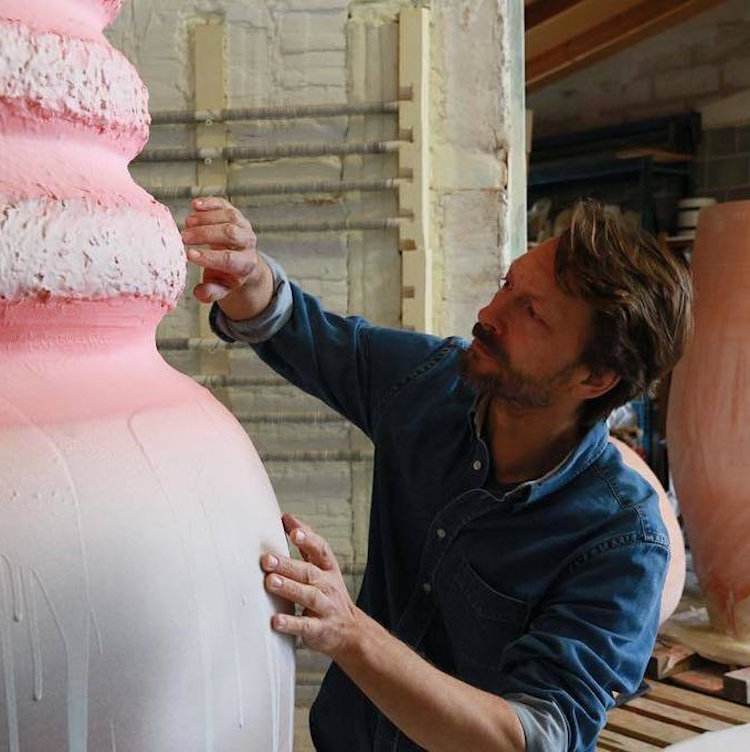BERLIN, Germany — For a few years Berlin artist Anselm Reyle was a casualty of the 2008 recession. According to Bloomberg’s article, Reyle fell victim to the chaotic whims of the art market, rather than to his own shortcomings. The recession made people less likely to spend money on art, which resulted in fewer sales for Reyle, which created a feedback loop in which the artist watched the price of his work deflate and never recover. The same speculation that tanked the world’s economy in 2008 seemed to work its diabolical will over artists like Reyle.
Above image: Anselm Reyle in the studio.
Artists themselves usually have little to do with the price swings. And while they reap little benefit from their soaring secondary markets—collecting nothing when their work sells at auction—they can be hurt when those sales crumble. As their stars fade and collectors, even the nonspeculative ones, drift toward more fashionable subjects, it can be devastating. In February 2014, Reyle announced his retirement. His studio costs, which during the boom he estimated to be as much as $900,000 a month, were too high to justify continuing, he told the German magazine Die Welt. “The whole situation was surreal,” he said. “Not necessarily pleasantly surreal, either.” Reyle didn’t respond to a request for comment.
The real kick in the teeth of it is that once this happens there are some, like collector advisor Thea Westreich, who will pretend it is the fault of the artist, not the market. She explained Reyle’s decline as “the art world coming to its senses.” What she said is insulting, as though Reyle’s success was a fluke, a silly fad like pet rocks or roller discos. The market can’t be wrong, the invisible hand can’t be wrong, our taste in art can’t be wrong; therefore, it must be the artist who is wrong. Luckily for the market, the artist is disposable. Westreich admits that the emperor has no clothes, but she blames a man who had no control over what speculation did to his career. He’s eating the losses of someone else’s gambling problem.
Video courtesy of Vernissage TV.
This is all prologue to say that Reyle retired about two years ago. It sounded like a messy breakup. The good news is that Reyle is back, and he’s working in ceramics. Some of his works were featured at Art Basel this year. He is also exhibiting Keramik at the CFA Berlin (April 29 – July 9), his first display of new work since 2014. From the CFA:
“The vases are all handmade in the style of Fat Lava. This term refers back to a particular form of glazing that was developed in the 1960s and is reminiscent of the large pores found in solidified lava flows. These days, however, in professional circles, Fat Lava is now generally associated with West German ceramics from the 1950s to the 1970s, which are characterised by bold colours, striking glazes and experimental combinations using a great variety of forms. After the war, these pieces were for the most part industrially produced – an approach that emerged from the democratic desire for universal accessibility and simultaneously led to an ambivalent situation for the ceramic factories, which now focused on mass production rather than creating elaborate single pieces. Despite their simplified form, streamlined for industrial production, the vases stood out from other ceramics due to extensive research on new glazing techniques and bold colours, which were applied by hand. In addition to the primarily matte dark Fat Lava glazing, orange red, cadmium yellow and cobalt blue are among the colours representative of this style. Contrary to their former semi-industrial origins and short production time, the vases for Reyle’s series were created in collaboration with traditional ceramic factories, due to their size and in some cases highly sophisticated processes.
Many of the vessels are cracked or have some other deformity. The CFA states that the artist staged these accidents, scarring them before they went off to the kiln. He’s apparently interested in the Japanese art form of Kintsugi, the practice of repairing a broken vessel and enhancing it. A difference I see (and read biographical messages into it if you want) is that Reyle is content to let the imperfections sit; he makes no attempt to fix them.
Bill Rodgers is the Managing Editor of cfile.daily.
Do you love or loathe these works of contemporary ceramic art? Let us know in the comments.



Add your valued opinion to this post.